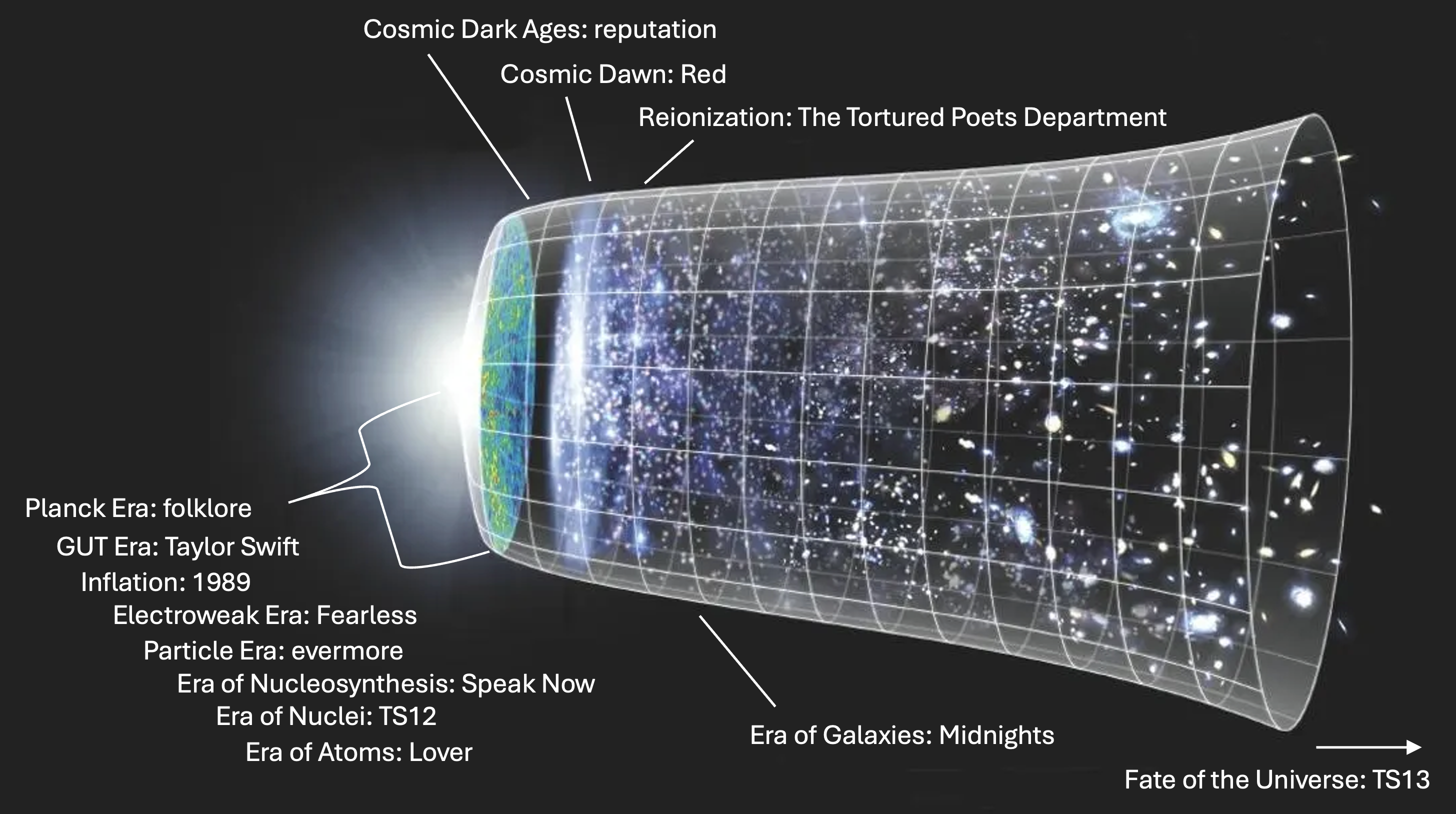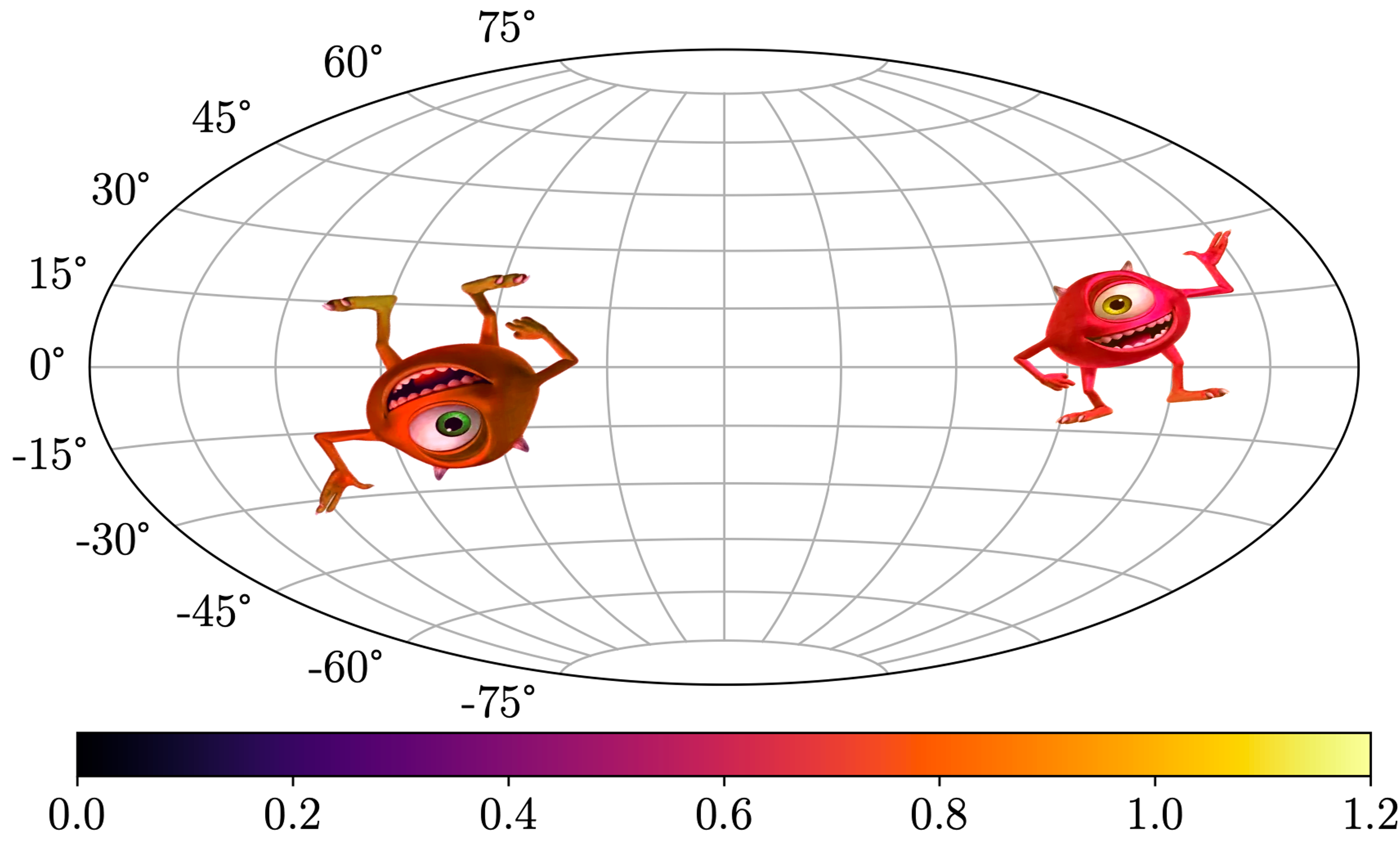arXiv Fool's Day 2025 (Taylor's Version)
Posted by David Zaslavsky on — Comments(this post is late due to some real-life stuff, my apologies!)
Academia, you have outdone yourselves. This year I’m adding 21 new entries to my “asymptotically comprehensive” list of April 1 arXiv joke papers, just edging out last year’s record of 20.
Two of this year’s papers investigated cosmological symbology in the music of Taylor Swift. We learned from Sophie Newman and Ana Sainz de Murieta that Taylor (or at least her music) promotes astrophysics in her albums and is evidently a particular fan of multimessenger astronomy. And Jane Bright has revealed a surprising connection between The Eras Tour and cosmological eras, even suggesting that Taylor may have the ultimate fate of the universe in her hands, through her subsequent (13th) album. Maybe it’s time to become a Swiftie…

We also had another pair of topically linked papers about cats. One from Viktor Toth observes the ability of cats to apparently, defy gravity, and proposes a theoretical explanation. Fully compliant with general relativity! And perhaps also suggesting a link to quantum field theory. You have to love anything that includes the phrase “cat stress-energy-momentum tensor”. In the other, Harman Deep Kaur, Mariagrazia Trapanese, and Kirill Zatrimaylov reported on a coherent macroscopic superposition of cat states: Lola (the nice one) and Mola (the… other one), which oscillate into each other on roughly a 12-hour timescale.
Prolific Acta Prima Aprilia contributor and friend maybe occasional reader of the blog, Mike Lund, has definitively proved that astronomers are getting less creative over time by tracking the change in complexity of constellation names throughout eras of history.
It’s not often I see joke papers in the math categories, but we’ve got a good one this year: Emily Pottebaum posted an empirical study of which numbers are funniest. Spoiler alert: it’s apparently zero, followed closely by 83. Maybe 1 wouldn’t be so lonely if it’d talk to its neighbors.
That conclusion gets put to the test in the discovery of Jacquetium by Emmanuel Jacquet: a new element with atomic number zero, and definitively the last cisuranic element to ever be discovered.
Lu Li and Zhengyi Shao posted a study with a surprising conclusion: nearby open star clusters appear to have their longest axes aligned toward the solar system. But the key word is “appear”, as they explained in a disclaimer: there’s more uncertainty in distance measurements than direction measurements, which tends to stretch the maximum likelihood estimation of the cluster region along the line of sight. I love papers like this that are joking but actually make an important point about something real studies should watch out for!
Another paper that makes a good point about real science, Chun Huang (also occasional reader of the blog) studied pulse profile modeling for neutron stars. A pulse profile represents how the intensity of radiation coming from the pulsar varies by the direction in which it’s emitted, and astrophysicists like to fit pulse profile models to the data and use that to draw conclusions about the structure of the star and its magnetic field. Chun’s paper questions how much we can really trust our assumptions about the pulse profile shape by using a candidate pulse profile based on Mike Wazowski’s face (from Monsters Inc.). This figure captures the spirit of arXiv Fool’s perfectly.

Another result along the same lines that I found quite impressive was this formula for the area of a triangle from Connor Hainje and David W. Hogg:
On one hand, how cool is it that you can still publish a paper for finding a new formula for the area of a triangle? On the other hand, as the authors say, “no insights of any kind were gained from these results”.
Making one of the most important points of all, Sophie Rosu posted a study of the optimal crispiness and softness of cookies, inspired by an earlier paper (discussed on this blog) about Jaffa cakes. It has long been suspected (by me), if not proven, that cookie quality leads directly to enhancements in research quality, so this is an area where followup work is most welcome. Fortunately the author has plans!
We had another food-themed (ish) paper from Frederic V. Hessman, Andrew Collier Cameron, and Keith Horne, reporting on the detection of whiskey on the extrasolar planet GJ 1132 b. Clearly this means there are aliens there, and they are very drunk, or at least have a superhuman tolerance for alcohol.
Dominick M. Rowan and John D. Roberts posted a brilliant proposal (with disturbing implications) to use the empty space in figures for brand promotion. With sample code! Everyone else seems to be getting sponsorships these days; why not scientists? The authors suggest this could cover open access fees for way more people, and if it’s really successful, maybe some impoverished grad students could start buying themselves food.
I didn’t even manage to fully read all the papers, much less write about them, but a quick skim of the abstracts will tell you there are even more great ones waiting for your perusal. Check out the full list! And we can look forward to even more of the same next year… although, if Joanne Tan is right that the arXiverse may be entering its “big crunch” phase, we might have reason to be concerned. Submit more papers, everyone, and let’s keep the arXiv Fool’s tradition strong!